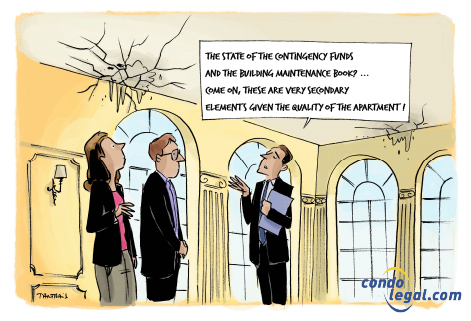.png)
Buying an apartment in a co-ownership is a major investment in a lifetime. In order to avoid being caught off guard during the steps prior to this acquisition, you will need to be well accompanied. After finding the apartment, the first thing to do is to appreciate the condition of it, as well as that of the building that houses it. To do things right, you need to seek the services of a building inspector. The latter will examine the unit and building that are of interest to you.
Some buyers mistakenly believe, when it comes to a purchase in a tower, that it is not useful. However, buying without an inspection can generate significant and unpredictable costs. The purchaser will also find it difficult to demonstrate that he acted as a prudent buyer during a possible recourse for a hidden defect.
Pre-Purchase Inspection and its benefits
The pre-purchase inspection requires the essential participation of a building inspector (a member of an association that guarantees that their members hold and maintain professional liability insurance for errors and omissions) The buyer of a dwelling in an existing co-ownership must, under all circumstances, link his offer to purchase to a pre-purchase inspection. In this regard, in accordance with the Regulation respecting brokerage requirements, professional conduct of brokers and advertising, a real estate broker is required to recommend that you have a complete inspection carried out by a professional or a recognized building inspector, who must meet certain requirements.
This exercise allows you to withdraw from a transaction (if applicable) under a suspensory condition, in the event that such inspection does not meet your requirements. In addition, the pre-purchase inspection allows you to make an informed purchase and avoid unpleasant surprises, as you are able to:
How to choose a building inspector
The pre-purchase inspection requires the essential participation of a building inspector (a member of an association that guarantees that their members hold and maintain professional liability insurance for errors and omissions) or a building professional, such as a member of the Order of Professional Technologists of Quebec, the Order of Engineers of Quebec, or the Order of Architects of Quebec. Such professionals are compelled to comply with the standards of their professions and it is compulsory that they subscribe and maintain professional liability insurance for errors and omissions. Finally, if the building inspector you have chosen is not a member of a professional order or has not been recommended to you by a real estate broker, you will need to ensure that he or she is covered by liability insurance for this type of activity, and require that after the inspection, he or she provide you with a detailed written report of the work he or she has done.
The scope of the mandate
The inspection mandate generally includes the visual inspection of the property. The purpose of this exercise is to detect and describe the construction’s defects and lack of maintenance of the building in existence, on the date of the inspection. Following the inspection, a purchase inspection report is drafted.
When you buy an apartment in a divided co-ownership building, you become the owner of your unit (private portion), but also the owner of an undivided share of the common portions (e.g., land, balconies, structural work of the building such as exterior walls and roof). In the circumstances, it is best to ask the mandated building inspector not to limit his inspection to the private portion, but also to include the common portions, where the most important and costly problems are usually found. The inspection of the common portions provides an opportunity to make a judgement on the general condition of the building. For example, the advanced deterioration of a garage structural concrete slabs or roof often reveals poor maintenance of the building.
Keep in mind that an inspector cannot always examine thoroughly the common portions. However, this inspection should allow you to have a good general understanding of the immovable. In reviewing the certificate of the state of the immovable, the maintenance logbook, the asset management plan and the contingency fund study, he will be able to determine if the schedule of maintenance of the building has been respected. After the inspection, you will have a good overview of the situation. You will then be in a position to decide if you go ahead with the purchase of the apartment of your dreams, and if appropriate, renegotiate the purchase price.
 WHAT YOU SHOULD KNOW ! Even though it is not legally mandatory, the pre-purchase inspection is an essential step in any divided co-ownership buying process. As for the common portions, it often requires the agreement of the syndicate of co-owners. Inspection of common portions can be very expensive and can be difficult to carry out. The building inspector's analysis of the documents relating to the co-ownership can therefore be useful.
WHAT YOU SHOULD KNOW ! Even though it is not legally mandatory, the pre-purchase inspection is an essential step in any divided co-ownership buying process. As for the common portions, it often requires the agreement of the syndicate of co-owners. Inspection of common portions can be very expensive and can be difficult to carry out. The building inspector's analysis of the documents relating to the co-ownership can therefore be useful. WHAT TO KEEP IN MIND: The seller cannot be held responsible for an apparent defect affecting both the private portion sold and the common portions. After the acquisition, it will be difficult for the buyer to claim from his seller the reimbursement of the sums he must pay under the terms of a special assessment, to deal with the execution of work to be undertaken by the syndicate for the rehabilitation of a concrete slab in the indoor parking lot eaten up by de-icing salts.
WHAT TO KEEP IN MIND: The seller cannot be held responsible for an apparent defect affecting both the private portion sold and the common portions. After the acquisition, it will be difficult for the buyer to claim from his seller the reimbursement of the sums he must pay under the terms of a special assessment, to deal with the execution of work to be undertaken by the syndicate for the rehabilitation of a concrete slab in the indoor parking lot eaten up by de-icing salts. WARNING! The condition precedent of the inspection included in the offer to purchase must, at all times, provide sufficient time to allow the inspection report presenting the results to be read. This report must include a statement indicating the findings observed.
WARNING! The condition precedent of the inspection included in the offer to purchase must, at all times, provide sufficient time to allow the inspection report presenting the results to be read. This report must include a statement indicating the findings observed.






